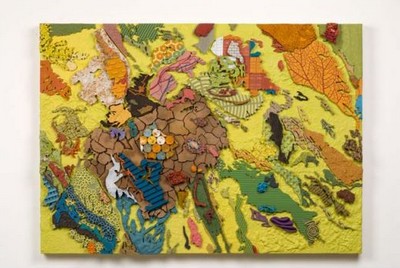Roxy Paine: Normal Fault
Kasmin Gallery, New York
November 4 - December 23, 2021
Topographic, 2021
60 1/2 x 84 x 8 inches / 153.7 x 213.4 x 20.3 cm
Courtesy of the artist
Kasmin presents an exhibition of new work by ROXY PAINE (b. 1966, New York). Comprising an installation of thirteen relief paintings and one of the artist’s Dioramas, the works extend Roxy Paine’s epistemological investigations into the interconnected structures that constitute both the natural world and the systems humanity has imposed on it.
Obscuring the delineation between abstraction and the representation of landscape, soil, and flora, the works deliberately obscure the scale of their subjects to present simultaneously micro- and macroscopic perspectives of biological and geological phenomena, as well as the maps we use to notate the world around us. Roxy Paine’s constructions of these phenomena, including mycelium, molds, and rock material, entangle the dichotomy of beauty and destruction as they draw parallels between the patterns associated with the organic, the industrial, and the digital. Whether cells, bolts, or pixels, Roxy Paine repeatedly brings the accumulation of these formative units into absurdity, asking us to question how perception is framed, filtered, and codified.
Roxy Paine’s exploration into stratigraphy acts to interweave three distinct temporal frameworks: geological, fungal, and human. Time becomes the subject, as well as the perception of time and the way that the understanding of geology forces a different frame of reference. The artist has long been fascinated by fungi and its ability to productively transform dead matter into building blocks that other entities can harness to create new life. Their traditional medicinal uses, to induce perceptual shifts and philosophical epiphanies, is also of interest.
Three works in the exhibition use the internal geometric structure of the American flag as a compositional beginning. Layered with complex symbolism and rendered in lifelike layers of sediment, they consider our planet’s ongoing transformation in both political and biological terms. Drawing on the irony of a country at pains to assert its authority despite rapid ecological decline, they lay bare the pallid resemblance that political or social systems have to the effortless perfection and complexity of nature.
Reverent of the immensity of geological time, Gros Ventre (2021) is titled after a wilderness situated nearby to the artist’s studio and residence in Wyoming. The area’s historic vulnerability to landslides has contributed to a distinctive and contrasting terrain, forming a mountain range which is broken by faults that form an asymmetrical arch. Roxy Paine uses this as a starting point to look at nature and the lenses through which we variously understand, analyze, mythologize, romanticize, and disturb the natural world.
Works that emphasize the man-made entropy of the earth are intentionally fraught in tone. In Large Green Pools (2021), what appears as a volcanic landscape is interrupted not by the chlorophyllic burst of plant life but by toxic craters almost extraterrestrial in their vibrancy. Large Sun (2021) and Small Sun (2021) present the eventual absorption of earth in space while also conjuring associations of rapidly multiplying bacteria or fungi, signaling the presence of death or the dying. Roxy Paine revels in this theatre of nature as he condemns its destruction by pollutants and emissions.
Distinct from the arborescence of the artist’s Dendroids (the structure of which mimic the branch-like networks of leaf structures and microchips), these works consider multiplicity, proliferation, and the slow layering of sediment over time to create the environments we recognize on earth during the epoch of the anthropocene. Presenting devastated landscapes, charred by fire or nuclear disaster, these works also develop previous major installations such as Desolation Row (2017).
ROXY PAINE’s work is the subject of numerous museum exhibitions worldwide including Roxy Paine: Serotonin Reuptake Inhibitor at Beeler Gallery, Columbus College of Art & Design, OH, 2016–17; Natura Naturans at Villa Panza, Varese, Italy, 2015–16; and Roxy Paine: Scumaks and Dendroids at Nelson-Atkins Museum, Kansas City, MO in 2011.
In 2009, Roxy Paine was selected to create Maelstrom, a site-specific installation for the rooftop garden at the Metropolitan Museum of Art. His work has also been installed in prominent public venues In New York City such as Madison Square Park in 2009 and Central Park in 2002.
Roxy Paine has been the recipient of many prestigious awards, including John Simon Guggenheim Memorial Foundation Fellowship, the Asher B. Durand Award by the Brooklyn Museum and the Trustees Award for an Emerging Artist by the Aldrich Contemporary Art Museum. His work is included in prominent public collections, including the Museum of Modern Art New York, Museum of Modern Art San Francisco, and the Museum of Contemporary Art Los Angeles, National Gallery Sculpture Garden, Washington, D.C., North Carolina Museum of Art, Seattle Art Museum, The Whitney Museum of American Art, New York, and Hirshhorn Museum & Sculpture Garden, Washington, D.C.
Major monographs of the artist’s work were recently published by Rizzoli in 2018, and by Skira in 2021.
Text by Marc Mayer and Tan Lin
Published by Rizzoli Electa, November 2018
Hardcover, 288 p.
Dioramas
Edited by Saul Anton
Texts by Mia Kang, Steven Matijicio and Michael Goodman
Published by Skira, 2021
Hardcover, 176 p., 145 ill.
KASMIN GALLERY
509 West 27th Street, New York, NY 10001



